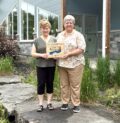Archive » Headline News » News
Crime rates down,co-operation up
October 28, 2015
By Tony Pearson
There’s a saying in the media: “If it bleeds, it leads” – meaning that stories about crime and violence get a lot of coverage. So much coverage can lead to feeling that crime is rampant, even out of control. Distress mounts, and calls are voiced to “get tough on crime”, usually with more police and longer sentences.
Yet Bancroft statistics, like those across Ontario, show a different picture. They indicate that the crime rate is decreasing. According OPP Bancroft detachment figures, violent crime was down nearly 40% between January and August of 2015, compared with the same period the year before, and property crime was down over 25%.
Officer Brian Goodwin explained that the overall incidence of crimes in the area is relatively small, and thus capable of big shifts from small numbers. However, he noted that stats for the entire province showed the same trend, and have done so for some time. The question, of course, is why.
Part of the answer is demographic. As the population ages, crime rates decline, since seniors are not typically violent bank robbers, drug smugglers, or hitmen (even those with small pensions tend to remain law-abiding). But new policing methods, focused on community partnerships, are also a major factor. And these new methods could have a favourable impact on local ratepayers’ taxes.
The central idea is to target appropriate services to those who need them. Officer Goodwin noted that while crime is down, calls to the police are up. But the majority of these calls do not involve a chargeable offence. This, he suggest, is because the OPP call lines are open 24/7, and some type of response is guaranteed. So the police are dealing with situations that could well be better managed by mental health or addictions services, or in the case of domestic disputes, by family counselling or children’s aid services. In fact, Dr. Hugh Russell, a social psychologist who works with Bancroft’s Policing committee, states that three quarters of calls to police have some mental health aspect.
So Bancroft has been approaching the situation on a community safety and well-being basis, an approach which works to engage the citizens, businesses, agencies and organizations of the area in a coordinated effort to not only reduce policing calls, but a range of emergency responses. The focus of these efforts is prevention of crime through an increase in both education about risk reduction and overall community “wellness”.
At times, that can all sound like jargon. But it’s not unlike the famous African saying about it taking a village to raise a child. Dr. Russell talks about people looking out for each other, and organizations forming partnerships to address root causes of social disorder.
Bancroft OPP detachment commander Jim Locke, in his report to September’s meeting of the town policing committee, noted a new program to identify repeat users of police service calls, in order to direct them to local agencies which can better meet their needs. He also highlighted a upcoming program to assist caretakers in tracking people with Alzheimer’s (“Project Lifesaver”).
Officer Goodwin pointed to a recent conference put on by the Metis Nation of Ontario to look at how to deal with problems arising from gambling and addiction. This brought together a broad range of local health and social service agencies to take a “big picture” look at signs and symptoms of addiction, as well as remedial programs and the referral process. He also noted OPP work with business owners, and with cottagers and their organizations, to reduce their risk of property crime like theft and vandalism.
Dr. Russell stresses the importance of primary health care and mental health agencies building more bridges between their services. He also mentioned the role of pre-natal, neo-natal, and “early years” education for parents – which would also expand their circle of friends and neighbours who can help. “The best protection against domestic abuse,” he stated, “is a broad social network – breaking down barriers that leave people isolated.” He observed that “anyone’s life has many turning points where a timely community intervention can help.”
Bancroft’s approach linking crime reduction to community development and wellness programs has already drawn favourable comment from the Ontario attorney-general. In the long run, it might also draw favourable comment from ratepayers. Under the new funding formula which determines how much towns pay for OPP services, part of the amount varies with the number of calls the OPP must handle. If some of these are assigned to a more appropriate agency, this cost might decrease.
“In the end,” Dr. Russell summarized, “a community needs to take responsibility for its own safety and well-being.”




















